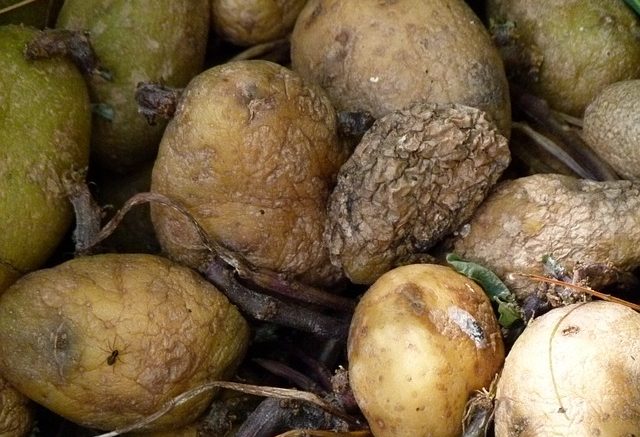For the Treasure Valley Pest Alert: Kasia Duellman, Nora Olsen, Pamela J.S. Hutchinson, James Woodhall
Cull potatoes must be kept non-viable on a daily basis after May 15 in Idaho’s upper Snake River valley east of Raft River. Even though April 15, the date for the same requirement west of Raft River has passed, there are reports of non-destroyed cull piles in the Magic and Treasure Valleys. Check for the cull management regulations and dates in your state.
Cull potatoes are those that are not acceptable for use due to failure to meet size, grade, or quality standards, or due to over-supply. These “waste” potatoes accumulate in what are commonly described as cull piles that if left untended can be sources of current-season disease, insect pest, and nuisance problems.
For example, cull potatoes can harbor the pathogen that causes late blight, and University of Idaho research shows they are a reservoir for Potato virus Y and other potato viruses.
Cull piles can attract crop pests such as aphids which can transmit viruses that infect potato and Colorado potato beetle. Even if culls are not sprouting in the pile, the late blight pathogen can sporulate on infected tubers. Decomposing cull piles can also lead to public nuisance issues such as flies, odor, and leaching of excess nutrients into ground and surface waters. In addition, soil associated with cull potatoes can be infested with pests such as the powdery scab pathogen, nematodes, and weed seeds.
For these reasons, the Idaho State Department of Agriculture requires cull potatoes from all potato operations to be rendered non-viable on a daily basis after April 15th in western Idaho and after May 15th in eastern Idaho as previously mentioned. This regulation continues through September 20 th and is in place to help eliminate a potential source of problems for the current season crop and to aid in maintaining the overall integrity of Idaho’s potato crop production and quality.
Cull disposal must be accomplished in an environmentally safe, legal, and effective way. Monitor culls diligently. Don’t assume that freezing temperatures or prior management practices have killed the culls.
Options for destroying cull potatoes include:
1. Winter field spreading
2. Burial
3. Livestock feed
4. Compost
5. Plastic covers
6. Chemical applications
More information on the first four options can be found at
http://www.cals.uidaho.edu/edComm/pdf/CIS/CIS0814.pdf (Cull and Waste Potato Management, CIS814).
Plastic covers. An additional management strategy includes the use of plastic covers, especially for cull piles that have not been adequately managed prior to now. The use of black plastic sheeting to cover cull potatoes prevents the movement of spores from the cull pile to neighboring fields, minimizes an aphids ability to acquire viruses from sprouting foliage.
Chemical application to kill sprouts and foliage. Cull piles are technically non-crop areas and some herbicides labeled for non-crop uses may be somewhat effective at killing sprouts and subsequent foliage emerging from culls. Multiple applications may be necessary, especially since resprouting can occur. There are currently no herbicides capable of “killing” the tuber so there is a possibility of potato pathogen persistence in this “living reservoir” even though sprouting foliage is controlled.
Examples of herbicides labeled for control of broadleaves in noncrop areas (active ingredient and associated, possible trade names are listed): glyphosate (Roundup PowerMax and others), MCPA (various trade names), 2,4-D (various), dicamba (Banvel, Clarity, Vanquish), bromoxynil (Buctril), aminopyralid (Milestone), clopyralid (Stinger, Transline), clopyralid + 2,4-D (Curtail), diuron (Karmex), bromacil + diuron (Krovar), flumioxazin (Payload), fluroxypyr (Starane Ultra), imazapic (Plateau),
imazapyr (Arsenal), triclopyr (Garlon).
Several desiccation products, including those used for potato vine-kill can be used: carfentrazone-ethyl (Aim), diquat (Reglone and others), glufosinate-ammonium (Rely), paraquat (various Gramoxone products), pyraflufen ethyl (Vida).
NOTE: Herbicide application to cull piles could be considered spot spraying, and wand, single-nozzle type sprayers would be used. Herbicide labels may have sections containing spot-spraying instructions. Rates are often based upon an area of 1,000 sq ft and amount of product (and adjuvant) to mix per gallon of water. Rates also might be based on a percentage-of-volume basis.
Apply enough spray to cover the foliage but NOT to the point of runoff. Don’t forget the recommended adjuvant(s). As always, when treating cull piles with herbicides, avoid drift onto off-target areas including cropped fields due to the potentials for immediate or long-term crop damage.

